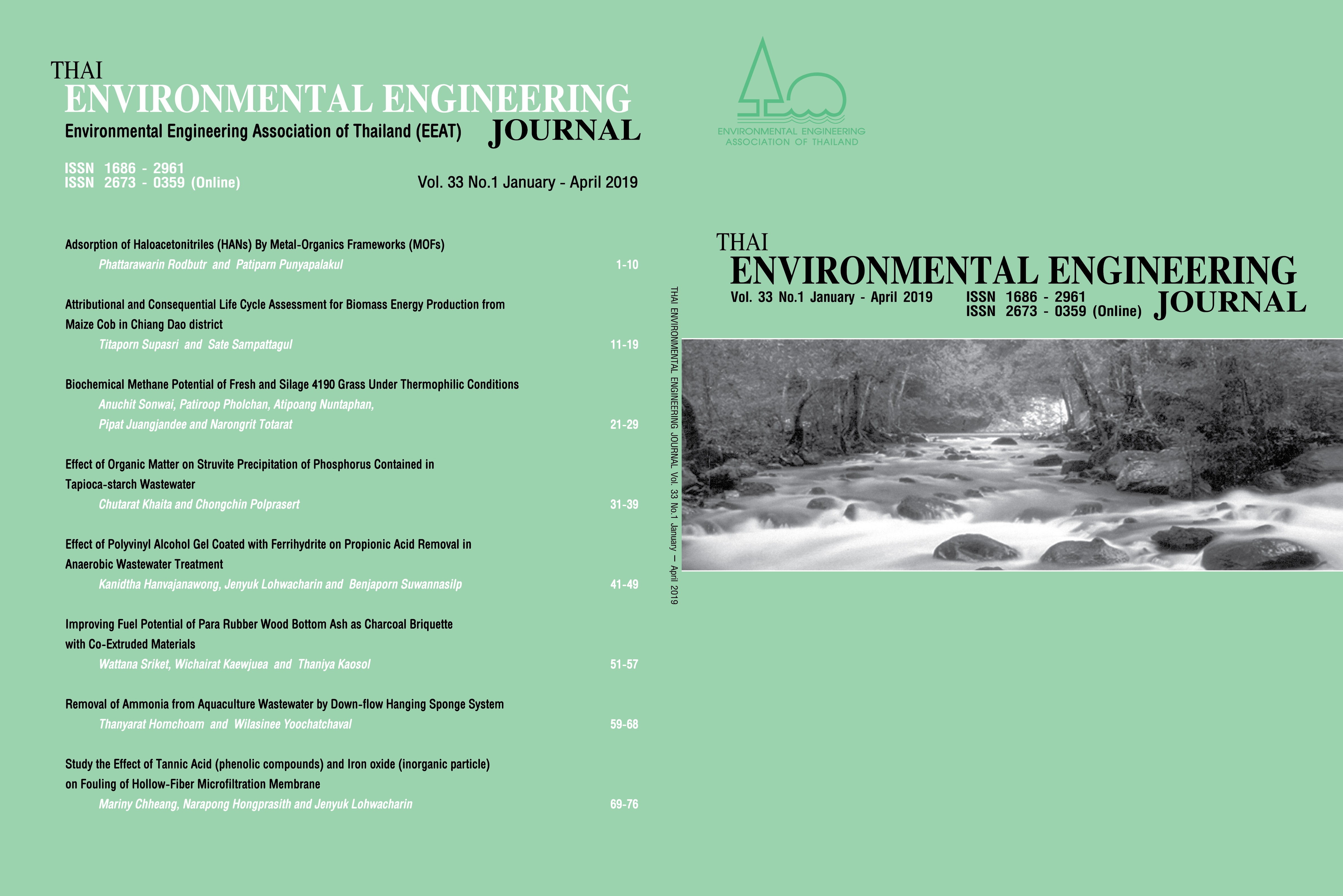Removal of Ammonia from Aquaculture Wastewater by Down-flow Hanging Sponge System
Main Article Content
Abstract
This study investigates the efficiency of a biological nitrogen removal system for aquaculture effluent treatment of a down-flow hanging sponge (DHS). The experiment has been performed for 212 days. The DHS system had hydraulic retention time (HRT) decrease from 8 hours to 1 hour (8 hours, 5 hours, 3 hours and 1 hour). From the experiment data showed that the amount of ammonia after passing through the system at an HRT 1 hour there was 0.42 mg-N/L. The system provided average removal efficiencies for ammonia and Total nitrogen of 99% and 69%, respectively. The water quality profile results revealed the ammonia, BOD, SS and VSS are most eliminated in the first segment of DHS system. DHS system can perform nitrification reducing ammonia (NH3) toxicity in aquaculture wastewater. The study confirmed that the DHS system provided nitrification process and the overall DHS system provided high-performance aquaculture effluent treatment system.
Article Details
References
[2] Wang, H.J., Xiao, X.C., Wang, H.Z., Li, Y., Yu, X.M. Liang, W.S. Feng, J.C. Shao, M. Rybicki, Q., Jungmann, D. and Jeppesen, E. 2017. Effects of high ammonia concentrations on three cyprinid fish: Acute and whole-ecosystem chronic tests. Sci. Total Environ. 598: 900-909.
[3] Furukawa, A., Matsuura, N., Mori, M., Kawamata, M., Kusaka, J., Hatamoto, M. and Yamaguchi, T. 2016. Development of a DHS-USB recirculating system to remove nitrogen from a marine fish aquarium. Aquaculture. Eng. 74: 174-179.
[4] Kamstra, M., Blom, E., and Terjesen, B.F. 2017. Mixing and scale affect moving bed biofilm reactor (MBBR) performance. Aquaculture. Eng. 78: 9-17. [1]
[5] Bernardia, F., Zadinelob, I., Alvesc, H., Meurera, F. and Santosa, L. 2018. Chitins and chitosans for the removal of total ammonia of aquaculture effluents. Aquaculture. 483: 203-212.
[6] Adlin, N., Matsuura, N., Ohta, Y., Hirakata, Y., Maki, S., Hatamoto, M. and Yamaguchi, T. 2017. A nitrogen removal system to limit water exchange for recirculating freshwater aquarium using DHS-USB reactor. Environ. Technol. 39: 1577-1585.
[7] Onodera, T., Tandukar, M., Sugiyana, D., Uemura, S., Ohashi, A. and Harada, H. 2014. Development of a sixth-generation down-flow hanging sponge (DHS) reactor using rigid sponge media for post-treatment of UASB treating municipal sewage. Bioresour. Technol. 152: 93-100.
[8] Tawfik, A., Ohashi, A. and Harada, H. 2006. Sewage treatment in a combined up-flow anaerobic sludge blanket (UASB)-down-flow hanging sponge (DHS) system. Biochem. Eng. J. 29: 210-219.
[9] Tanikawa, D., Nakamura, Y., Tokuzawa, H., Hirakata, Y., Hatamoto, M. and Yamaguchi, T. 2018. Effluent treatment in an aquaponics-based closed aquaculture system with single-stage nitrification–denitrification using a down-flow hanging sponge reactor. Int. Biodeter. Biodegr. 132: 268-273.
[10] Fleifle, A., Tawfik, A., Saavedra, O., Yoshimura, C. and Elzeir, M. 2013. Modeling and profile analysis of a down-flow hanging sponge system treating agricultural drainage water. Sep. Purif. Technol. 116: 87-94.
[11] Onodera, T., Yoochatchaval, W., Sumino, H., Mizuochi, M., Okadera, T., Fujita, T., Banjongproo, P. and Syutsubo, K. 2014. Pilot-scale experiment of down-flow hanging sponge for direct treatment of low-strength municipal wastewater in Bangkok, Thailand. Bioproc. Biosyst. Eng. 37: 2281-2287.
[12] Tandukar, M., Mechdar, I., Uemura, S., Ohashi, A. and Harada, H. 2006. Potential of a novel sewage treatment system for developing countries: long term evaluation. J. Environ. Eng. 32 (2): 166-172.


